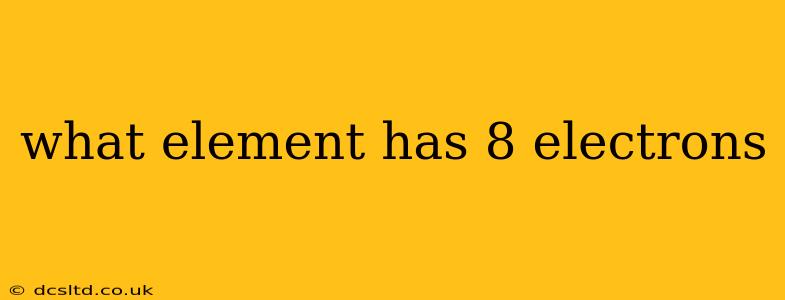The element with 8 electrons is oxygen (O). However, it's important to understand that this refers to a neutral oxygen atom. The number of electrons in an atom determines its chemical properties and how it interacts with other elements. Let's delve deeper into this and answer some related questions.
What is the Atomic Number of an Element with 8 Electrons?
The atomic number of an element corresponds to the number of protons in its nucleus. In a neutral atom, the number of protons equals the number of electrons. Therefore, an element with 8 electrons has an atomic number of 8.
How Many Protons and Neutrons Does Oxygen Have?
Oxygen (O), with atomic number 8, has 8 protons. The number of neutrons can vary, resulting in different isotopes of oxygen. The most common isotope, Oxygen-16, has 8 neutrons. Other isotopes exist, such as Oxygen-17 and Oxygen-18, which have different numbers of neutrons.
What is the Electron Configuration of Oxygen?
The electron configuration describes how electrons are arranged in energy levels or shells around the nucleus. For oxygen, the electron configuration is 1s²2s²2p⁴. This means:
- 1s²: Two electrons in the first energy level (s orbital).
- 2s²: Two electrons in the second energy level (s orbital).
- 2p⁴: Four electrons in the second energy level (p orbitals).
This specific electron configuration is what gives oxygen its characteristic chemical reactivity.
Why Does the Number of Electrons Matter?
The number of electrons in an atom's outermost shell, known as valence electrons, dictates its chemical behavior. Oxygen, with six valence electrons (2s²2p⁴), readily forms chemical bonds to achieve a stable octet (eight electrons) in its outermost shell. This is why oxygen is highly reactive and forms many different compounds.
What are Some Common Compounds of Oxygen?
Oxygen's high reactivity leads to the formation of countless compounds. Some of the most common include:
- Water (H₂O): Essential for life, water is formed by oxygen bonding with two hydrogen atoms.
- Carbon Dioxide (CO₂): A crucial part of the carbon cycle, carbon dioxide is formed by oxygen bonding with one carbon atom.
- Rust (Iron Oxide): The oxidation of iron forms various iron oxides, which we commonly refer to as rust.
Understanding the number of electrons in an atom is fundamental to grasping its chemical properties and how it interacts with other elements to form the diverse world of compounds around us. While oxygen (with 8 electrons in its neutral state) is the most prominent example, other ions and molecules will possess different numbers of electrons depending on their charge and bonding characteristics.
